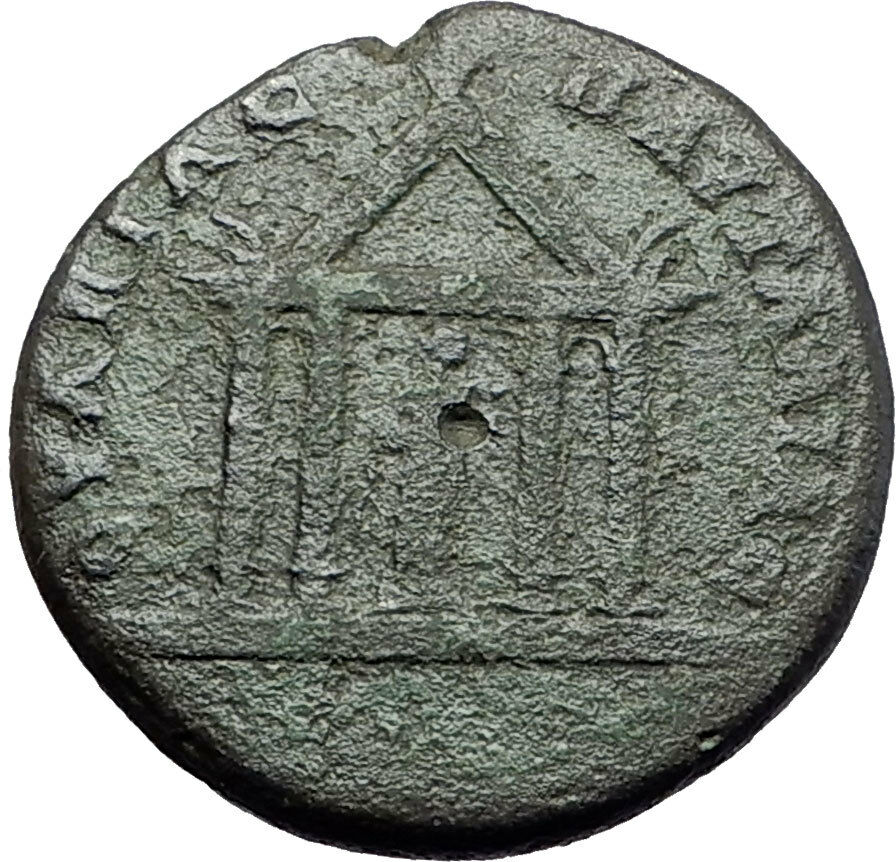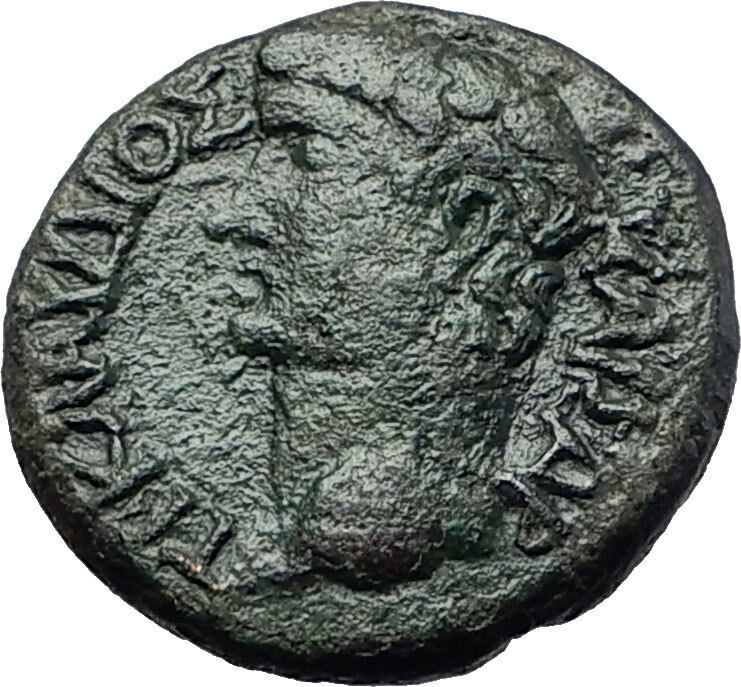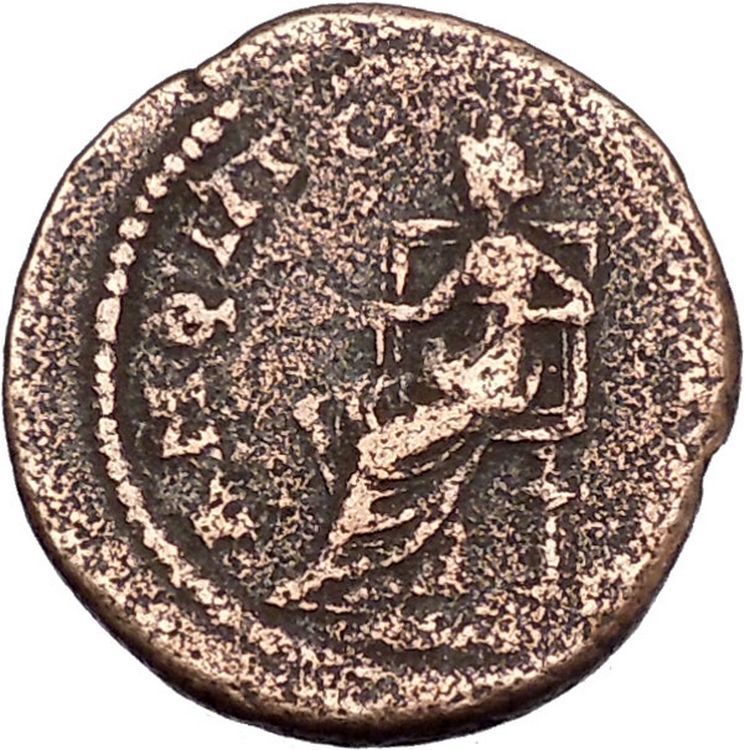|
Constantius Gallus – Roman Caesar: 351-354 A.D.
Bronze AE3 16mm (2.12 grams) Constantinople mint: 351-354 A.D.
Reference: RIC VIII 122
DN FL CL CONSTANTIVS NOB CAES, bare-headed, draped, cuirassed bust right
FEL TEMP REPARATIO, soldier spearing fallen horseman who is bare-headed,
bearded, reaching backwards. CONS in ex.
You are bidding on the exact item pictured, provided with a Certificate of Authenticity and Lifetime Guarantee of Authenticity.
 The military of ancient Rome, according to Titus Livius, one of the more illustrious historians of Rome over the centuries, was a key element in the rise of Rome over “above seven hundred years” from a small settlement in Latium to the capital of an empire governing a wide region around the shores of the Mediterranean, or, as the Romans themselves said, ”mare nostrum”, “our sea.” Livy asserts The military of ancient Rome, according to Titus Livius, one of the more illustrious historians of Rome over the centuries, was a key element in the rise of Rome over “above seven hundred years” from a small settlement in Latium to the capital of an empire governing a wide region around the shores of the Mediterranean, or, as the Romans themselves said, ”mare nostrum”, “our sea.” Livy asserts
“… if any people ought to be allowed to consecrate their origins and refer them to a divine source, so great is the military glory of the Roman People that when they profess that their Father and the Father of their Founder was none other than Mars, the nations of the earth may well submit to this also with as good a grace as they submit to Rome’s dominion.”
Titus Flavius Josephus, a contemporary historian, sometime high-ranking officer in the Roman army, and commander of the rebels in the Jewish revolt, describes the Roman people as if they were “born ready armed.” At the time of the two historians, Roman society had already evolved an effective military and had used it to defend itself against the Etruscans, the Italics, the Greeks, the Gauls, the maritime empire of Carthage, and the Macedonian kingdoms. In each war it acquired more territory until, when civil war ended the Roman Republic, nothing was left for the first emperor, Augustus, to do except declare it an empire and defend it.
The role and structure of the military was then altered during the empire. It became less Roman, the duties of border protection and territorial administration being more and more taken by foreign mercenaries officered by Romans. When they divided at last into warring factions the empire fell, unable to keep out invading armies.
 During the Roman Republic, the function of the military was defined as service to the ”Senatus Populusque Romanus” – an agency designated by ‘SPQR’ on public inscriptions. Its main body was the senate, which met in a building still extant in the forum of Rome. Its decrees were handed off to the two chief officers of the state, the consuls. They could levy from the citizens whatever military force they judged was necessary to execute such decree. This conscription was executed through a draft of male citizens assembled by age class. The officers of the legion were tasked with selecting men for the ranks. The will of the SPQR was binding on the consuls and the men, with the death penalty often assigned for disobedience or failure. The men were under a rigorous code, known now for its punitive crucifixion. During the Roman Republic, the function of the military was defined as service to the ”Senatus Populusque Romanus” – an agency designated by ‘SPQR’ on public inscriptions. Its main body was the senate, which met in a building still extant in the forum of Rome. Its decrees were handed off to the two chief officers of the state, the consuls. They could levy from the citizens whatever military force they judged was necessary to execute such decree. This conscription was executed through a draft of male citizens assembled by age class. The officers of the legion were tasked with selecting men for the ranks. The will of the SPQR was binding on the consuls and the men, with the death penalty often assigned for disobedience or failure. The men were under a rigorous code, known now for its punitive crucifixion.
The consular duties were of any type whatever: military defense, police work, public hygiene, assistance in civil disaster, health work, agriculture, and especially construction of public roads, bridges, aqueducts, buildings, and the maintenance of such. The soldiers were kept busy doing whatever service needed to be done: soldiering, manning vessels, carpentry, blacksmithing, clerking, etc. They were trained as required, but also previous skills, such as a trade, were exploited. They brought to the task and were protected by the authority of the state.
The military’s campaign history stretched over 1300 years and saw Roman armies campaigning as far east as Parthia (modern-day Iran), as far south as Africa (modern-day Tunisia) and Aegyptus (modern-day Egypt) and as far north as Britannia (modern-day England, south Scotland, and Wales). The makeup of the Roman military changed substantially over its history, from its early history as an unsalaried citizen militia to a later professional force, the Imperial Roman army. The equipment used by the military altered greatly in type over time, though there were very few technological improvements in weapons manufacture, in common with the rest of the classical world. For much of its history, the vast majority of Rome’s forces were maintained at or beyond the limits of its territory, in order to either expand Rome’s domain, or protect its existing borders. Expansions were infrequent, as the emperors, adopting a strategy of fixed lines of defense, had determined to maintain existing borders. For that purpose they constructed extensive walls and created permanent stations that became cities.
Flavius Claudius Constantius Gallus (ca. 325/326 – 354), better known as Constantius Gallus, was a member of the Constantinian dynasty and Caesar of the Roman Empire (351-354). Gallus was consul three years, from 352 to 354.
Son of Julius Constantius by his first wife Galla, Gallus’ paternal grandparents were Western Roman Emperor Constantius Chlorus and his second wife Flavia Maximiana Theodora.
Julius Constantius was also a half-brother of Roman Emperor Constantine I, and thus Gallus was a first cousin of Emperors Constantine II, Constantius II and Constans.
The older sister of Gallus, of unknown name, was the first wife of Constantius II. Julius Constantius had married a second wife, Basilina, who had borne him a son, Flavius Claudius Iulianus, later emperor, and known as Julian.
Appearance
Gallus was very good looking, with soft blond hair.
Youth
Gallus was born in Massa Veternensis, Italia, after his father had returned from exile. In 337, during the purges that hit the imperial family after the death of Constantine I, Gallus saw his father and his elder brother killed, probably by order of his cousin Constantius. The only imperial males surviving were the three Emperors, Gallus, and Julian, who were probably too young or ill (Banchich) to be a menace to Constantius.
With regards to Gallus’ youth, the most accepted view is that he lived with Julian under Eusebius, bishop of Nicomedia, then in Constantinople since 340 (when Eusebius became bishop of the capital). After 341 (death of Eusebius), Constantius sent Gallus and Julian to the imperial manor in Macellum, Cappadocia. An alternative view accepts hints from sources that want Gallus in Ephesus to study, and then going to Macellum from an exile in Tralles.
Caesar
In 350, Magnentius had rebelled and killed the emperor Constans, claiming the purple. Constantius II prepared to move against the usurper, but needed a representative in the East, so he called Gallus at Sirmium, raised him to the rank of caesar (15 March 351), gave him the name Constantius, and strengthened the bonds with his cousin by allowing Gallus to marry his sister Constantina. Gallus and Constantina, who probably shared her brother’s aim of controlling the young caesar, set up residence in Antioch.
During his rule, Gallus had to deal with a Jewish rebellion in Judea/Palestine (see War against Gallus). The rebellion, possibly started before Gallus’ elevation to caesar, was crushed by Gallus’ general, Ursicinus, who ordered all the rebels slain.
Gallus was saved from an assassination plot by a woman, who revealed that some members of her household were planning the murder. Some sources, among whom are Joannes Zonaras, claim that this plot had been organized by Magnentius in order to distract Constantius from Magnentius himself.
Some sources (Philostorgius) claim Gallus’ generals won a campaign against the Sassanids. Others, basing their views on an almost-peaceful situation between Sassanids and Romans, dismiss this claim. In 354, Gallus sent the Comes Orientis, Nebridius, against the Isaurians, who had been raiding the city of Seleucia on the Tigris.
As a consequence of the need to gather food for the troops of a Persian campaign or because of drought, the grain supply in Antioch decreased. In order to counter the higher price of grain, Gallus forced the passage of some laws regardless of the opinion of the Senate, thus alienating the support of the senatorial class of Antioch. Ammianus Marcellinus, a philo-senatorial writer, tells how the anger of the people of Antioch for the famine was diverted by Gallus towards the consularis Syriae Theophilus, who was killed by the mob.
Ammianus reports also that Gallus and Constantina started several trials for magic against wealthy people, ending in the execution of innocents and in the confiscation of their wealth. The same source claims that Gallus walked anonymously in Antioch by night, asking passersby for their opinion on their caesar, while Julian records the great amount of time spent by Gallus at the Hippodrome, probably to obtain popular support.
Doubting his cousin’s loyalty, Constantius reduced the troops under Gallus, and sent the Praetorian Prefect Domitianus to Antioch to urge Gallus to go to Italy. Different sources tell different stories, but all agree that Gallus arrested Domitianus and the quaestor Montius who had come to his aid, and that the two officers were killed.
The arrest of Montius led to the discovery of what seems to be a plot to elevate an usurper against Gallus. The conspirators had the support of two tribuni fabricarum (officers of the weapons factories) who had promised the weapons for an uprising (Ammianus Marcellinus, 14.7.18), and probably of the troops in Mesopotamia, as well as of the rector of the province of Phoenice. All of those involved in the plot were sentenced to death.
Fall and death
Constantius was informed of the trials in Antioch during a campaign against the Alamanni. Having signed a peace with the Germanic tribe, Constantius decided to settle the matter with his cousin. First he summoned Ursicinus to the West, whom he suspected to have been inciting Gallus in order to create the occasion for a revolt and the usurpation of his own son.
Next, Constantius summoned Gallus and Constantina to Milan. Constantina left first, in order to gain some of her brother’s trust, but died at Caeni Gallicani in Bithynia. Gallus, whose bonds to Constantius had been weakened, stayed in Antioch. Constantius tried to lure Gallus, sending the tribunus scutariorum Scudilo to tell Gallus that Constantius wanted to raise him to Augustus. Gallus desiring to finally obtain the rank of Augustus, took Constantius’s bait and left Antioch to meet him. Gallus in an exhibition of his presumed soon to be Augustus powers, staged a chariot race in Constantinople’s Hippodrome and crowned the victor, an honor reserved only for those that are Augustus. This insolence of Gallus enraged Constantius, further adding to his dislike for the upstart Caesar. In an attempt to further isolate Gallus from any form of military protection, Constantius had the garrisons removed from the towns in Gallus’s path.
When Gallus arrived to Poetovio in Noricum, Barbatio, an officer who had been supporting Gallus’ dismissal within Constantius’ court, surrounded the palace of the caesar and arrested him, stripping Gallus of the imperial robes, but assuring him that no harm would come to him. Gallus was led to Pola, Istria (now Pula, Croatia). Here he was interrogated by some of the highest officials of Constantius’ court, including the eunuch praepositus cubiculi Eusebius and the agens in rebus Apodemius. Gallus tried to put the blame of all of his actions on Constantina, but Constantius sentenced him to death; The emperor later changed his mind, and ordered the caesar to be spared, but Eusebius ordered that the news was not to reach the executioners.
|





 The military of ancient Rome, according to Titus Livius, one of the more illustrious historians of Rome over the centuries, was a key element in the rise of Rome over “above seven hundred years” from a small settlement in Latium to the capital of an empire governing a wide region around the shores of the Mediterranean, or, as the Romans themselves said, ”mare nostrum”, “our sea.” Livy asserts
The military of ancient Rome, according to Titus Livius, one of the more illustrious historians of Rome over the centuries, was a key element in the rise of Rome over “above seven hundred years” from a small settlement in Latium to the capital of an empire governing a wide region around the shores of the Mediterranean, or, as the Romans themselves said, ”mare nostrum”, “our sea.” Livy asserts During the Roman Republic, the function of the military was defined as service to the ”Senatus Populusque Romanus” – an agency designated by ‘SPQR’ on public inscriptions. Its main body was the senate, which met in a building still extant in the forum of Rome. Its decrees were handed off to the two chief officers of the state, the consuls. They could levy from the citizens whatever military force they judged was necessary to execute such decree. This conscription was executed through a draft of male citizens assembled by age class. The officers of the legion were tasked with selecting men for the ranks. The will of the SPQR was binding on the consuls and the men, with the death penalty often assigned for disobedience or failure. The men were under a rigorous code, known now for its punitive crucifixion.
During the Roman Republic, the function of the military was defined as service to the ”Senatus Populusque Romanus” – an agency designated by ‘SPQR’ on public inscriptions. Its main body was the senate, which met in a building still extant in the forum of Rome. Its decrees were handed off to the two chief officers of the state, the consuls. They could levy from the citizens whatever military force they judged was necessary to execute such decree. This conscription was executed through a draft of male citizens assembled by age class. The officers of the legion were tasked with selecting men for the ranks. The will of the SPQR was binding on the consuls and the men, with the death penalty often assigned for disobedience or failure. The men were under a rigorous code, known now for its punitive crucifixion.




